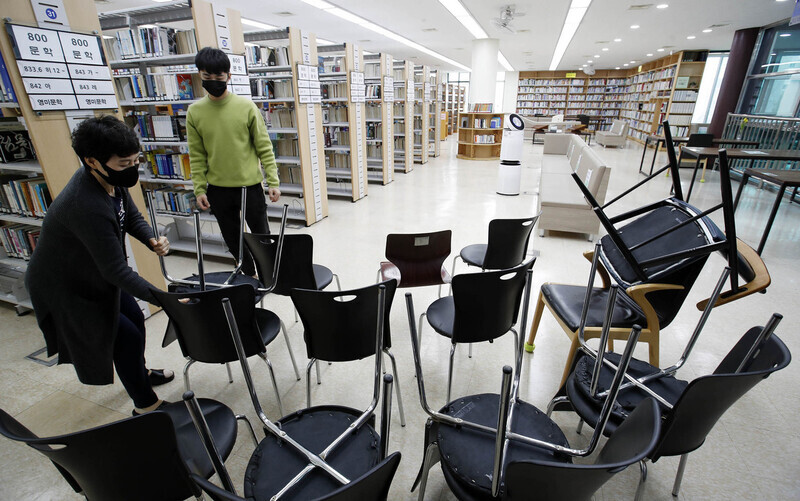hankyoreh
Links to other country sites 다른 나라 사이트 링크
S. Korea exceeds 300 cases for first time in 81 days

On Nov. 18, South Korea’s daily tally of new COVID-19 cases rose above 300 for the first time in 81 days. Level 1.5 social distancing measures are set to take effect in some parts of Greater Seoul on Nov. 19. But if community outbreaks occurring around the country can’t be brought under control, there are concerns that Korea will face a third wave of the disease.
South Korea’s Central Disease Control Headquarters (CDCH) reported on Wednesday that 313 people had tested positive for COVID-19 on the previous day. Of the cases, 245 were transmitted locally, with 68 imported from overseas. The last time the daily caseload exceeded 300 was on Aug. 29, when 323 were reported.
“We’re in a crisis situation right now, and there are even pessimistic predictions that the whole country is about to see another wave of the disease,” said Second Vice Health Minister Kang Do-tae during a meeting of Korea’s Central Disaster and Safety Countermeasures Headquarters on Wednesday.
“We’ve entered a phase where the risk of infection has become routine — anyone can be infected anywhere, at any time,” Kang said.
The surge in new cases has been particularly steep in the densely populated Seoul Capital Area (SCA). As recently as the beginning of last week, only about 80 cases of COVID-19 were being reported there each day. But by Wednesday, that figure had soared to 181. Over the past week (Nov. 12-18), there has been an average of 126.6 new cases in and around Seoul each day.
As the number of new COVID-19 cases rapidly climbs, many are worried that Korea is seeing the beginning of a third wave. The first wave focused on the Daegu branch of the Shincheonji religious sect, while the second wave radiated out from Sarang Jeil Church in Seoul. But while government officials agree that the situation is grave, they say it’s too soon to define this as a “third wave.”
“The goal of level 1.5 [social distancing] is to quickly stop community outbreaks of the disease and to lessen the surge in patient numbers. It’s critical that we stabilize the situation without escalating to Level 2, which would inflict serious harm on people’s routines and livelihoods,” said Kang.
Level 1.5 rules will take effect in Seoul, Gyeonggi Province, and Gwangju on Nov. 19 and in Incheon on Nov. 23, capping the number of people allowed into public facilities.
If the daily caseload continues to register at 300 or more, the CDCH expects hospital beds around the country that have been reserved for critically ill patients to fill up in about two weeks. As of Nov. 17, there were 119 beds in the country immediately available for treating patients in critical condition.
Authorities’ calculations are based on the assumption that about 3% of COVID-19 patients become critically ill and stay in the hospital for an average of 25 days.
Gangwon Province only has two beds immediately available; South Jeolla Province only has one.
“It’s not a big problem yet, but the number of critical cases, which had hovered around 50, started to rise yesterday and today. We’re looking into ways to set aside more hospital beds for critically ill patients,” said Lee Chang-jun, the official in charge of managing hospital beds at the Central Disaster Management Headquarters.
In a related development, the CDCH said that the government would make dual tests for COVID-19 and influenza eligible for coverage under the national health insurance program on Nov. 19. That step eliminates the copay for the tests, which check for the two diseases at the same time.
By Choi Ha-yan, Suh Hye-mi and Choi Won-hyung, staff reporters
Please direct comments or questions to [english@hani.co.kr]

Editorial・opinion
![[Column] Season 2 of special prosecutor probe may be coming to Korea soon [Column] Season 2 of special prosecutor probe may be coming to Korea soon](https://flexible.img.hani.co.kr/flexible/normal/500/300/imgdb/original/2024/0426/3317141030699447.jpg) [Column] Season 2 of special prosecutor probe may be coming to Korea soon
[Column] Season 2 of special prosecutor probe may be coming to Korea soon![[Column] Park Geun-hye déjà vu in Yoon Suk-yeol [Column] Park Geun-hye déjà vu in Yoon Suk-yeol](https://flexible.img.hani.co.kr/flexible/normal/500/300/imgdb/original/2024/0424/651713945113788.jpg) [Column] Park Geun-hye déjà vu in Yoon Suk-yeol
[Column] Park Geun-hye déjà vu in Yoon Suk-yeol- [Editorial] New weight of N. Korea’s nuclear threats makes dialogue all the more urgent
- [Guest essay] The real reason Korea’s new right wants to dub Rhee a founding father
- [Column] ‘Choson’: Is it time we start referring to N. Korea in its own terms?
- [Editorial] Japan’s rewriting of history with Korea has gone too far
- [Column] The president’s questionable capacity for dialogue
- [Column] Are chaebol firms just pizza pies for families to divvy up as they please?
- [Column] Has Korea, too, crossed the Rubicon on China?
- [Correspondent’s column] In Japan’s alliance with US, echoes of its past alliances with UK
Most viewed articles
- 1[Column] Season 2 of special prosecutor probe may be coming to Korea soon
- 2No good, very bad game for Korea puts it out of Olympics for first time since 1988
- 3‘We must say no’: Seoul defense chief on Korean, USFK involvement in hypothetical Taiwan crisis
- 4Division commander ordered troops to enter raging flood waters before Marine died, survivor says
- 5Is Japan about to snatch control of Line messenger from Korea’s Naver?
- 6Korea’s 1.3% growth in Q1 signals ‘textbook’ return to growth, says government
- 7Is N. Korea threatening to test nukes in response to possible new US-led sanctions body?
- 8[Editorial] Korea’s surprise Q1 growth requires objective assessment, not blind fanfare
- 9[Editorial] New weight of N. Korea’s nuclear threats makes dialogue all the more urgent
- 10[Editorial] In the year since the Sewol, our national community has drowned